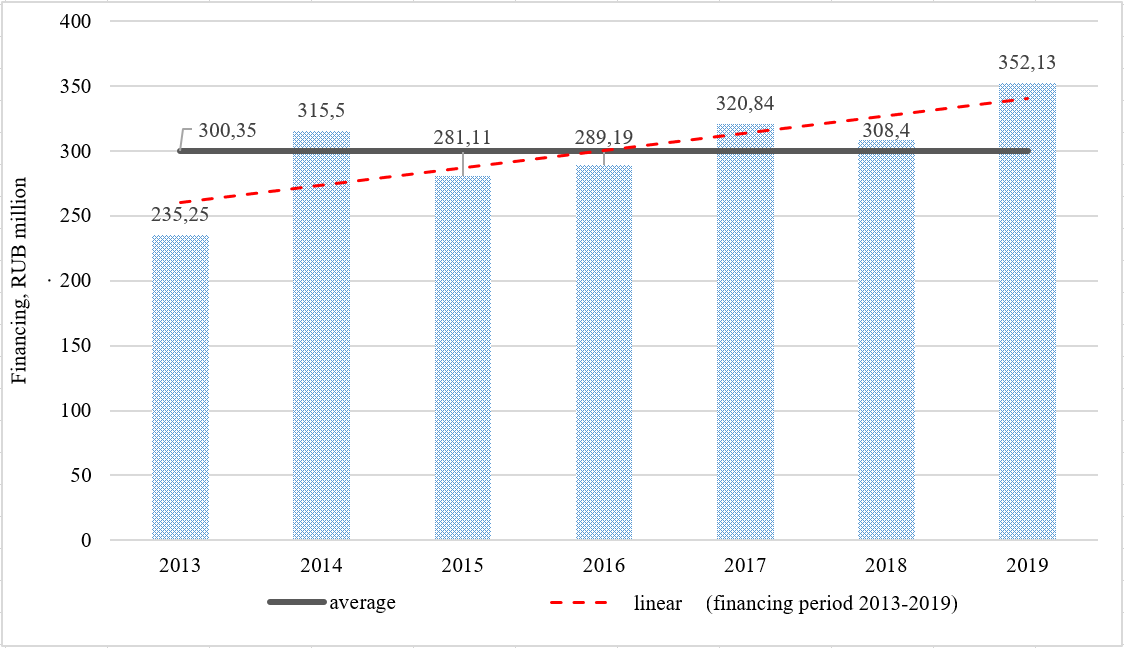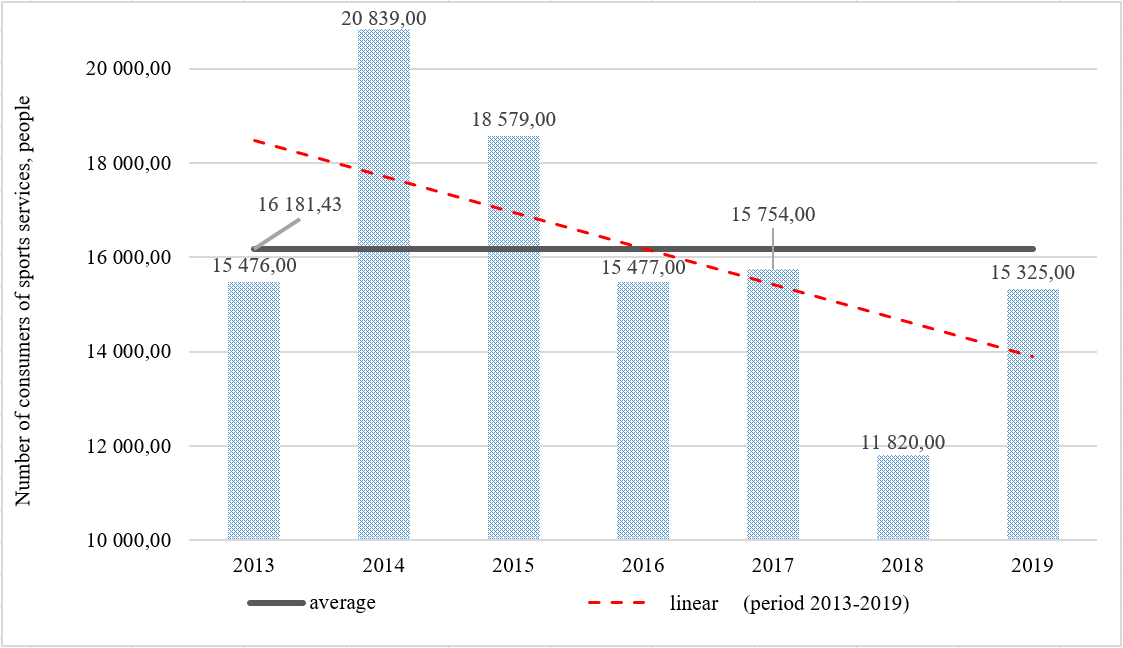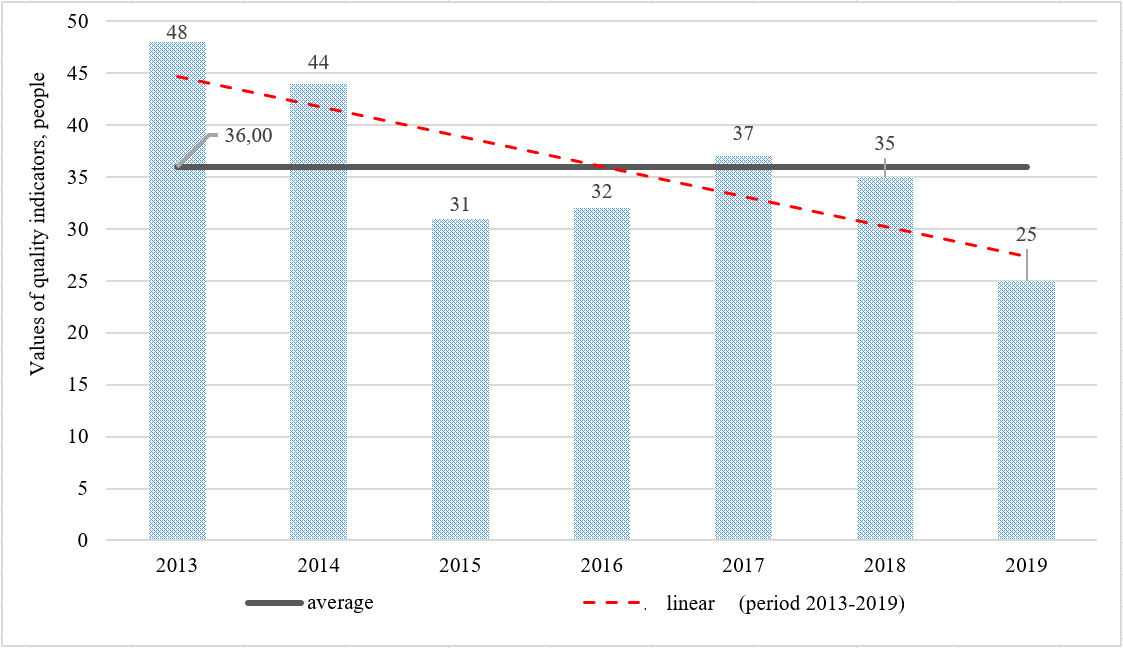Abstract
The paper provides a detailed analysis of statistical data on financing the sports industry from the budget of Izhevsk, and an assessment is made to achieve qualitative and quantitative indicators that characterize the effective use of spent budget funds. As a result, an overview of the state of the sports industry in Izhevsk was made. In the course of the calculations, it was found that during the period under review for 2013-2019, there was a positive trend in the financing of the industry. The change in the number of consumers of sports services and the quality indicators of consumers of sports services that have reached a certain level necessary for the implementation of the federal concept of the development of the sports industry showed negative dynamics. The results of the study can be used in planning the budget of the municipality for the sports industry, as well as in assessing the quality of the provision of sports services to the population. According to the results of the study, it is concluded that despite the annual increase in funding for the industry as a whole and unit costs per consumer of sports services, there is a negative trend in terms of the quantitative and qualitative composition of consumers of sports services. This may indicate either a discrepancy between the goals stated in the concept of industry development, or the ineffective use of budget funds.
Keywords: Budget financing, municipal budget, sports industry
Introduction
Sports as a sector of the economy is a system of institutions, enterprises and organizations, whose main economic function is to provide sports services. The performance of the sports industry should be the number of consumers of sports services, as expressed by people, and the quality of sports services, as expressed in the number of high-quality consumers of sports services (the number of athletes in national sports teams). The state, both at the regional and at the municipal level, is interested in increasing both indicators, in general terms, which can be formulated as a social return on investment (Millar & Hall, 2013; Makarov et al., 2018). An increase in the number of consumers of sports services leads to a healthier nation, an increase in efficiency, a decrease in the cost of medicine, etc. And the increase in quality indicators increases the prestige of the state in the international political arena. In both cases, the main stages of work start at the municipal level (Litvin et al., 2017).
Financial support of the sports industry from the budget of the municipality, for example, the city of Izhevsk, is carried out through a municipal order by financing each consumer according to the established standard. Accordingly, the number of consumers who can receive sports services from the municipal budget is limited (Generalov et al., 2017).
Problem Statement
The “cost-benefit” principle known in economics rather specifically defines that for every financial investment, be it commercial or budgetary investment, there should be measurable results. 80% of the financing of the sports industry in Russia consists of budget funding at the federal, regional and municipal levels (Ponkin, 2017). For these purposes, there are targeted funding programs at various levels. And the main problem of assessing the results of budget execution is to analyze the achievement of qualitative and quantitative indicators in the sports industry and also their relationship to each other.
Research Questions
The subject studied in the article is the result of the execution of the municipal budget provided for the sports industry. The identification of quantitative and qualitative indicators, as a rule, serves as an indicator for adjusting funding. In order to achieve the goals that the state sets before regional and municipal authorities, the analysis of financing the sectors of the national economy and, in particular, the sports industry is an important link in building the economy of all subjects and coordinating the actions of participants in the budget process, recipients and budget executors.
Purpose of the Study
The aim of the study is to analyze and assess the rationality of the use of funds allocated annually for the development of the sports industry from the budget of the municipal formation of Izhevsk.
Research Methods
Today, there are three main models of sports funding: American, European and Asian (Ponkin et al., 2014). In which the volume of state financial investments on average varies from 20 to 80%. In Russia, at all levels of the budget, financing of the sports industry is mainly carried out through budgetary institutions, by communicating to them the state (municipal) assignment (order). A municipal order (municipal task) is a document that establishes requirements for the composition, quality and (or) scope (content), conditions, procedure and results of the provision of municipal services (Chueva & Tonyan, 2017). On its basis, based on the amount of financial support, a budget list is drawn up, indicating all the necessary areas of expenditure (Duborkina et al., 2020; Petrova et al., 2018).
In Izhevsk, budgetary financing of the sports industry in the period from 2013 to 2019 totaled 2,102.42 million rubles. Data broken down for each year are presented in Table 1.
Table 1 shows that from 2013 to 2019 there are no sharp drops in the volume of financing, and in general there is a positive trend in financing the industry. The average volume of financing for the industry amounted to 300.35 thousand rubles per year. Figure 01 shows the ratio of funding by years, for the period under consideration, and the overall dynamics of funding.

The linear trend plotted on the graph shows that over the period under review, funding for the sports industry is growing (Polyakova & Shabrova, 2015). As a result of increased funding. Presumably, firstly, either the number of consumers, and secondly, or the quality of sports services should increase. Thirdly, at the best, they are both.
In Izhevsk, at the end of 2019, sports services were provided by 16 sports institutions in 49 sports. Data on the number of consumers of sports services in the period from 2013 to 2019 are presented in Table 2.
Figure 02 shows the dynamics of changes in the number of consumers of sports services.

The linear trend plotted on the graph shows that during the period under review there is a negative trend in the number of consumers of sports services. Thus, the first assumption about an increase in funding and a corresponding increase in the number of consumers is not confirmed.
For the same period, the values of indicators characterizing the quality of the provided sports services (the number of athletes in national sports teams) were made according to the data in Table 3.
Figure 03 shows the dynamics of changes in the quality indicators of sports services.

The linear trend plotted on the graph shows that during the period under review there is also a negative trend in the quality indicators of sports services. Thus, the second assumption about an increase in funding and a corresponding increase in quality is not confirmed (Chaliev & Ovcharov, 2007). Accordingly, the third assumption about the mutual growth of quantity and quality is not confirmed.
Table 4 shows the shares of qualitative indicators in relation to quantitative indicators for the period from 2013 to 2019.
As can be seen from the data in Table 4, the maximum value is 0.3102%. Note that in accordance with the federal regulatory document - the concept of training a sports reserve in the Russian Federation until 2025, this indicator should strive for 2.23%.
In accordance with the method of financing each consumer according to the established standard, the average costs per consumer for the period from 2013 to 2019 were according to the data in Table 5.
From the data presented in Table 5, it can be seen that there is an increase in costs per consumer. Such positive dynamics is formed both due to the annual increase in funding and due to a decrease in the number of consumers.
Findings
The increase in funding for the sports industry over the period under review, on the one hand, should serve as a message to increase the number of consumers of sports services, and on the other, to improve the quality of sports services. However, a decrease in the number of consumers of sports services with an increase in funding leads to an increase in costs per consumer and, as a result, should contribute to an increase in quality indicators, which corresponds to the federal concept of the development of the sports industry. The identified dynamics in terms of quantitative and qualitative indicators are negative, which raises a number of controversial questions regarding the effective use of budget funds (Parushina & Vasilieva, 2016). To clarify the reasons for this situation, additional, more detailed studies are required. In particular, in the context of all areas of expenditure: property maintenance, utilities, wages fund, purchase of sports equipment and inventory, etc., both of individual sports organizations that provide services to consumers and the types of sports that develop in them.
Conclusion
Funding for the sports industry should be aimed at achieving specific measurable results (Howard & Crompton, 2018), which are expressed in terms of the number of consumers of sports services, the quality of these consumers and their sports performance. For further analysis, it is necessary to deepen each of the spending areas that are foreseen in the sports industry, and also to compare direct costs and expenses for general business needs (Finagenova, 2017). Further comparison of the actual costs with the costs provided for in accordance with the cost standards will allow identifying "out-of-pocket" financing directions, which in turn will allow adjusting the budget. after analysis in these areas, it will be necessary to change the very approach to the distribution of funding (Litvin et al., 2018).
References
Chaliev, A. A., & Ovcharov, A. O. (2007). STATISTICS. Study guide. Part 1. Nizhny Novgorod, Nizhny Novgorod State University.
Chueva, T. I., & Tonyan, M. N. (2017). To the question about the budget legislation Russian Federation. Innovative scientific research: theory, methodology, practice, (pp. 191-194). Penza, Science and Education.
Duborkina, I. A., Sokolova, A. P., Sirazhdinov, R. Z., Petrina, O. A., & Mironova, M. N. (2020). Municipal assignment as an effective service quality control tool. REVISTA INCLUSIONES, S2-3, 342-352.
Finagenova, O. B., (2017). Analysis of the structure and dynamics of expenditures of the Russian Federation on the financing of sports. Izvestia St. Petersburg State Economic University, 3(105), 153-157.
Generalov, A. V., Evseev, A. S., Petukhov, R., & Knutov, A. (2017). Per capita financing in the field of physical culture and sports. Bulletin of sport science, 5, 8-13.
Howard, D., & Crompton J. (2018). FINANCING SPORT fourth edition. Virginia del Oeste. FiT Publishing a Division of ICPE/WVU-CPASS.
Litvin, A. V., Arkalov, D. P., & Szulikovskaja, V. V. (2018). Methodology for the distribution of budget funding by sport (sports federations) in the region: the example of the Udmurt Republic. Financial economics, 5(p.1), 74-79.
Litvin, A. V., Kazakov, A. N., & Esipovich, L. (2017). SOCIAL RETURN ON INVESTMENTS (SROI) IN SPORTS: MODIFIED MODEL. Theory and Practice of Physical Culture, 1, 14.
Makarov, A. M., Litvin, A. V., Lashkarev, A. N., & Arkalov D. P. (2018). SROI based sport school performance efficiency rating analysis. Theory and Practice of Physical Culture, 12, 63-65.
Millar, R., & Hall, K. (2013). Social Return on Investment (SROI) and Performance Measurement, Public Management Review, 15(6), 923-941.
Parushina, N. V., & Vasilieva, K. S. (2016). The system of indicators and development of methods of analysis of financial results. International journal of applied and fundamental research, 8-4, 593-596.
Petrova, O. A., Porvina, N. S., & Yakovleva, T. A. (2018). The budget list as a basis for the execution of the municipal budget. Scientific Notes Of The Komsomolsk-On-Amur State Technical University, 1(33), 120-105.
Polyakova, V. V., & Shabrova, N. V. (2015). Fundamentals of the theory of statistics. Yekaterinburg, Ural University.
Ponkin, I. V., Soloviev, A. A., & Grebnev, R. D. (2014). To the question about the content of the European sport model. Bulletin of Peoples' Friendship University of Russia, 2, 260-263.
Ponkin, I. V. (2017). State administration in the field of sports. Master's textbook. Buki Vedi.
Copyright information

This work is licensed under a Creative Commons Attribution-NonCommercial-NoDerivatives 4.0 International License.
About this article
Publication Date
01 July 2021
Article Doi
eBook ISBN
978-1-80296-112-6
Publisher
European Publisher
Volume
113
Print ISBN (optional)
-
Edition Number
1st Edition
Pages
1-944
Subjects
Land economy, land planning, rural development, resource management, real estates, agricultural policies
Cite this article as:
Arkalov, D. P. (2021). Analysis Of Budget Financing Of The Sports Industry At The Municipal Level. In D. S. Nardin, O. V. Stepanova, & V. V. Kuznetsova (Eds.), Land Economy and Rural Studies Essentials, vol 113. European Proceedings of Social and Behavioural Sciences (pp. 702-708). European Publisher. https://doi.org/10.15405/epsbs.2021.07.84

